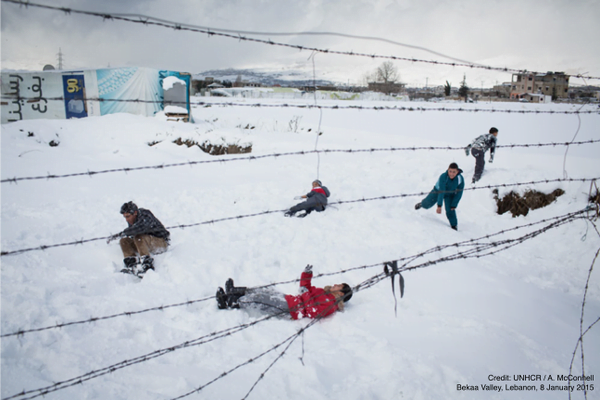

This is the fourth winter of the Syrian crisis. And with more Syrians displaced than ever before, a cold snap and snow storms are threatening the lives of refugees.
As winter settles into the Northern hemisphere for the next few months, providing adequate shelter, protection and healthcare for the millions of Syrian refugees in the Middle East is increasingly challenging. Last week, a fierce winter storm battered Lebanon, leaving men, women and children unequipped to deal with the cold in a very vulnerable position. In Syria, the harsh winter has already taken the lives of 11 displaced people, compounding the already harsh living conditions many find themselves in. Last week, two men and a small child died as they were crossing from Syria into Lebanon – only 200 meters away from the border checkpoint. Syrians, in particular the millions of displaced Syrians, are seeing their suffering compounded by having to survive winter, testing their resilience. Across the region, the UN is warning that upwards of 7 million children are “in desperate need of assistance”.
In Lebanon, even though the country is hosting upwards of one million Syrian refugees, there are no formal refugee camps, adding to the difficulty of providing adequate protection. Displaced people, who did not find locals or relatives to live with, or a place to rent, live in makeshift structures, unoccupied buildings and other ramshackle structures, leaving them extremely vulnerable to the elements. With little access to basic healthcare, and protective clothing, winter can be deadly. In the Za’atari refugee camp in Jordan, which hosts about 85,000 refugees, many are in an emergency situation after their tents collapsed under the weight of snow.
UNICEF is responding by providing warm clothing, blankets, heating supplies, cash and vouchers to more than 900,000 children in Syria, Iraq, Lebanon, Jordan and Turkey. But UNICEF is warning that this emergency support is failing to meet the actual needs, with the number of vulnerable children requiring protection increasing daily. Additionally, displacement patterns – with large numbers of people moving around in Syria, and across borders – are compounding the challenge of executing an effective humanitarian response. For example, UNICEF Lebanon had stockpiled 28,000 winter kits for children; already, the organization has provided winter items and vouchers to 200,000 children in the most exposed areas. Innovative electronic voucher programs, allowing refugees to purchase winter clothing from stores and markets, are helping, but are not sufficiently widespread to ensure that every displaced child has a coat, or appropriate winter shoes.
There is no end in sight for the Syrian conflict. In 2013, Brookings researcher Elizabeth Ferris traveled to the Middle East to meet with refugee families in Jordan and Lebanon, and, at the time, she reported that most of the people she spoke to believed that the war would last 10 to 15 years. Even if the conflict subsides sooner, there are enormous social, political and economic challenges that will need to be solved, and repatriation will neither be simple, automatic, or instantaneous. Knowing that displaced Syrians still have many winters ahead of them, the international community must mobilize – financially, operationally – to develop a humanitarian protection strategy that ensures that the suffering of displaced Syrians is not excessively compounded by winter.
